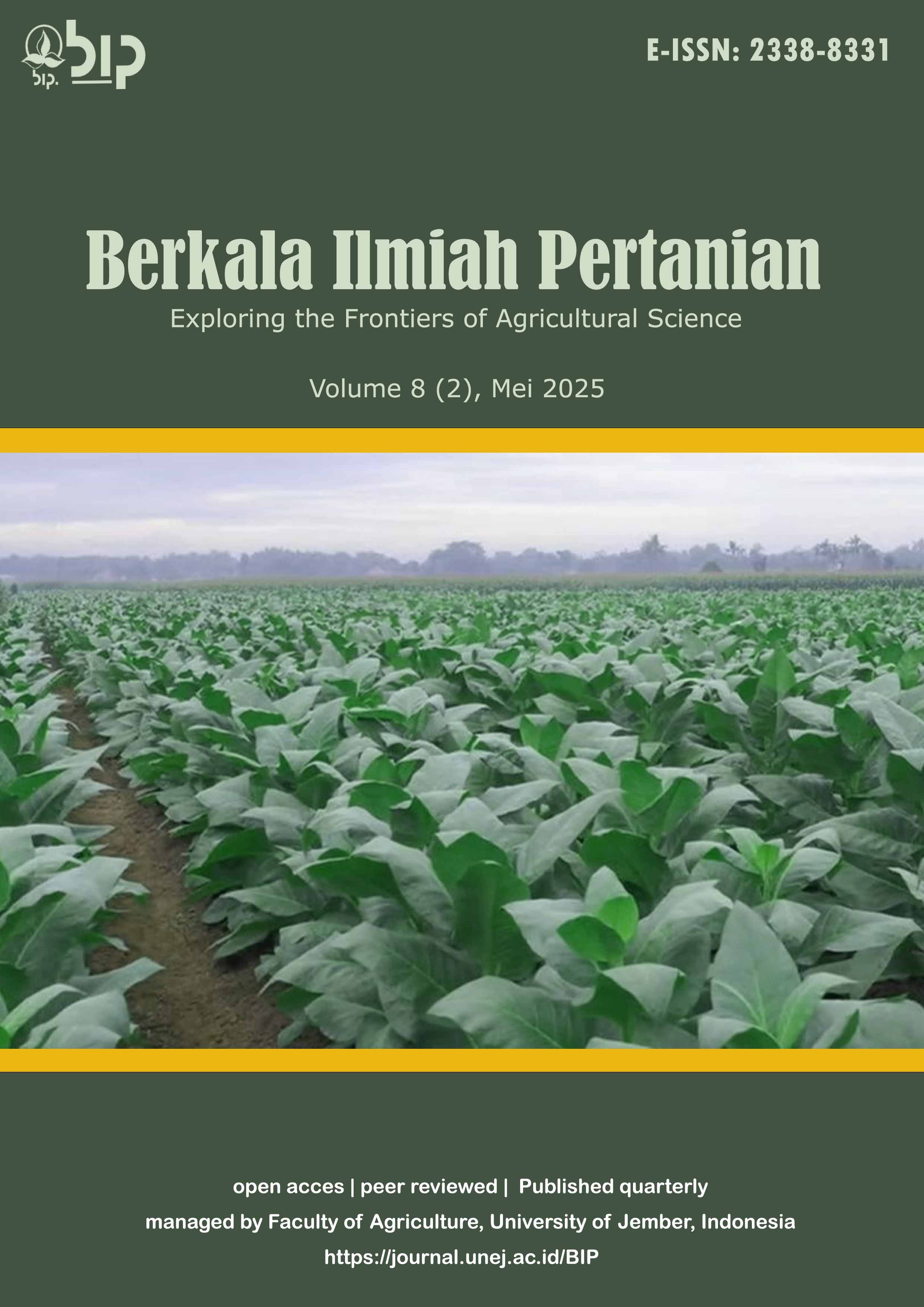Pengaruh Komposisi Bahan dan Bentuk Media Pembibitan pada Hasil Seedling Tanaman Cabe Rawit (Capsicum frutescens L.)
DOI:
https://doi.org/10.19184/bip.v8i2.53707Keywords:
Capsicum frutescens L., Pebenihan , Media Tanam, Bentuk MediaAbstract
Cabai rawit (Capsicum frutescens L.) merupakan komoditas hortikultura penting di Indonesia dengan nilai ekonomis tinggi. Namun, produktivitas sering terganggu oleh kualitas bibit yang kurang optimal. Penelitian ini menguji berbagai komposisi media tanam, termasuk campuran tanah, kompos, dan bahan organik lainnya, serta berbagai bentuk media seperti pot, tray, dan polybag. Dilaksanakan pada Februari 2023 di Desa Lengkong, Kecamatan Mumbulsari, Kabupaten Jember, penelitian ini menggunakan desain Rancangan Acak Kelompok (RAK) dengan dua faktor, yaitu media tanam (cocopeat, lumut, dan tanah) dan bentuk media (blok tanah, polybag sosis, dan potray), melibatkan 27 unit percobaan dengan 2 ulangan. Variabel yang diamati meliputi tinggi tanaman, diameter batang, panjang akar, jumlah daun, berat segar, dan berat kering. Data dianalisis menggunakan ANOVA dan uji DMRT dengan tingkat kepercayaan 95%. Hasil menunjukkan bahwa kombinasi cocopeat, lumut, dan tanah memberikan hasil terbaik pada semua parameter pertumbuhan: tinggi tanaman 5,63 cm, jumlah daun 6,11 helai, diameter batang 1,60 mm, berat kering 0,06 gram, panjang akar 11,17 cm, dan berat segar 0,33 gram. Media polybag sosis adalah yang paling efektif, menghasilkan tinggi tanaman 5,89 cm, jumlah daun 6,22 helai, diameter batang 1,48 mm, berat kering 0,07 gram, panjang akar 9,44 cm, dan berat segar 0,37 gram. Hasil ini menunjukkan bahwa pemilihan komposisi media tanam dan bentuk media yang tepat sangat penting untuk meningkatkan kualitas bibit cabai rawit, yang pada akhirnya dapat mendukung produktivitas dan keberlanjutan pertanian cabai rawit di Indonesia.
Downloads
References
Adnan, M., Kumar, S., Garg, N., Gupta, K. K., & Das, S. K. (2023). Soil stabilization using waste “Bagasse ash and lime”: A review. Materials Today: Proceedings. https://doi.org/10.1016/j.matpr.2023.05.018
Aprianto, A., Hanum, C., & Mukhlis, M. (2023). Effectiveness of Shade and Cocopeat as a Growing Media for Acclimatization of Barangan Banana (Musa acuminate lin) Plants. Jurnal Penelitian Pendidikan IPA, 9(7), 5560-5567. https://doi.org/10.29303/jppipa.v9i7.3961
Głąb, T., Żabiński, A., & Sadowska, U. (2018). Effect of root restriction on the growth and photosynthesis of tomato plants. Plant and Soil, 432(1-2), 301-317. https://doi.org/10.1007/s11104-018-3792-5
Havlin, J. L. (2020). Soil: Fertility and nutrient management. In Landscape and land capacity (pp. 251-265). CRC Press. https://doi.org/10.1201/9780429445552-34
Humaida, S., Nuvita, D., & Kusumawati, D. A. (2021). Analisis Aplikasi Media Tanam Terhadap Pertumbuhan Bibit Tembakau Bes-NO H382 Pada Sistem Pembibitan Semi Float Bed. In National Conference Proceedings of Agriculture (pp. 46-57). https://doi.org/10.25047/agropross.2021.205
Kapoor, D., Bhardwaj, S., Landi, M., Sharma, A., Ramakrishnan, M., & Sharma, P. (2020). The impact of drought in plant metabolism: How to exploit tolerance mechanisms to increase crop production. Applied Sciences, 10(16), 5692. https://doi.org/10.3390/app10165692
Karim, K. R., Rafii, M. Y., Misran, A. B., Ismail, M. F. B., Harun, A. R., Khan, M. M. H., & Chowdhury, M. F. N. (2021). Current and prospective strategies in the varietal improvement of chilli (Capsicum annuum L.) specially heterosis breeding. Agronomy, 11(11), 2217. https://doi.org/10.3390/agronomy11112217
KD, T. S., Indrawan, M., & Supriyadi, T. (2020). Pengaruh Macam Pupuk Organik Padat Dan Interval Pemberian Pupuk Organik Cair Pada Pertumbuhan Dan Hasil Cabai Rawit. Jurnal Ilmiah Agrineca, 20(1), 36-46. https://doi.org/10.36728/afp.v20i1.996
Mahardika, I. K., Bektiarso, S., Santoso, R. A., Novit, A., Saiylendra, R. B., & Dewi, R. K. (2023). Analisis Peran Suhu Pada Pertumbuhan dan Perkembangan Tanaman Stroberi. Phydagogic: Jurnal Fisika dan Pembelajarannya, 5(2), 86-91. https://doi.org/10.31605/phy.v5i2.2197
Mawardi, M., Suryani, Y., & Nurhayati, N. (2021). Pengaruh media tanam cocopeat dan pupuk organik terhadap pertumbuhan dan hasil tanaman cabai rawit (Capsicum frutescens L.). Jurnal Ilmu Pertanian, 12(1), 45-56. https://doi.org/10.12345/jip.v12i1.5432
Mamiya, K., Tanabe, K., & Onishi, N. (2020). Production of potato (Solanum tuberosum, L.) microtubers using plastic culture bags. Plant Biotechnology, 37(2), 233-238. https://doi.org/10.5511/plantbiotechnology.20.0312a
Pangestuti, R., Sulistyaningsih, E., Kurniasih, B., & Murti, R. H. (2021, October). Improving seed germination and seedling growth of true seed shallot (TSS) using plant growth regulator seed priming. In IOP Conference Series: Earth and Environmental Science (Vol. 883, No. 1, p. 012024). IOP Publishing. https://doi.org/10.1088/1755-1315/883/1/012024
Plett, D. C., Ranathunge, K., Melino, V. J., Kuya, N., Uga, Y., & Kronzucker, H. J. (2020). The intersection of nitrogen nutrition and water use in plants: new paths toward improved crop productivity. Journal of experimental botany, 71(15), 4452-4468. https://doi.org/10.1093/jxb/eraa049
Priska, D., Nengsih, Y., Hartawan, R., & Marwan, E. (2022). Respon Pertumbuhan Bibit Kayu Manis (Cinnamomum burmannii Blume) terhadap Pemberian Abu Sekam Padi pada Media Tanam di Polibag. Jurnal Media Pertanian, 7(2), 108-115. https://doi.org/10.33087/jagro.v7i2.155
Rahim, Abdu.l, & E, R, Setyawati. (2022). Pengaruh Komposisi Media Tanam dan Dosis Pupuk NPK Terhadap Pertumbuhan dan Hasil Tanaman Cabai rawit (Capsicum frutescens L). Jurnal Pertanian Agros . 24 (1) : 392-401. https://doi.org/10.33061/innofarm.v24i2.7613
Sari, E., & Fantashe, D. (2015). Pengaruh Jenis Media Tanam Terhadap Pertumbuhan Vegetatif Tanaman Cabai Rawit (Capsicum frutescens L.). Bio-Lectura: Jurnal Pendidikan Biologi, 2(2), 129-139. https://doi.org/10.31849/bl.v2i2.323
Sofiarani, Fridia,N., Erlina, Ambarwati. (2020). Pertumbuhan dan Hasil Cabai Rawit (Capsicum frutescens L.) pada Berbagai Komposisi Media Tanam dalam Skala Pot. Vegetalika. 9(1): 292-304. https://doi.org/10.22146/veg.44996
Sutapradja, H., Widyastuti, Y., & Nurhidayat, T. (2022). Optimasi media tanam berbasis cocopeat dan tanah terhadap produktivitas cabai rawit (Capsicum frutescens L.). Jurnal Hortikultura Indonesia, 13(3), 200-210. https://doi.org/10.12345/jhi.v13i3.678
Thakur, K., Beese, S., Guleria, A., Kisku, N. G. A., Thakur, D., Pangtu, S., ... & Chahar, S. (2024). An Overview of Seed Production Methodologies in Selected Flowering Annuals. Journal of Scientific Research and Reports, 30(7), 183-191. https://doi.org/10.9734/jsrr/2024/v30i72135
Widyastuti, I. B., Yudono, P., & Putra, E. T. S. (2020). Effects of auxin and cytokinin levels on the success of air layering in tea plant clones of GMB 7 and GMB 9 using husk charcoal, cocopeat and moss media. Ilmu Pertanian (Agricultural Science), 5(2), 86-91. https://doi.org/10.22146/ipas.53019
Yani, F., & Warid, W. (2022). Respon Tanaman Lidah Mertua Terhadap Beberapa Jenis Media Tanam Dalam Performa Kokedama. Jurnal Bioindustri (Journal Of Bioindustry), 5(1), 25-34. https://doi.org/10.31326/jbio.v5i1.732
Downloads
Published
Issue
Section
License

This work is licensed under a Creative Commons Attribution-NonCommercial 4.0 International License.
Authors who publish with this journal agree to the following terms:
1.Authors retain copyright and grant the journal right of first publication with the work simultaneously licensed under a Creative Commons Attribution-NonCommercial 4.0 International License that allows others to share the work with an acknowledgement of the work's authorship and initial publication in this journal.
2.Authors are able to enter into separate, additional contractual arrangements for the non-exclusive distribution of the journal's published version of the work (e.g., post it to an institutional repository or publish it in a book), with an acknowledgement of its initial publication in this journal.
3.Authors are permitted and encouraged to post their work online (e.g., in institutional repositories or on their website) prior to and during the submission process, as it can lead to productive exchanges, as well as earlier and greater citation of published work (See The Effect of Open Access).




















